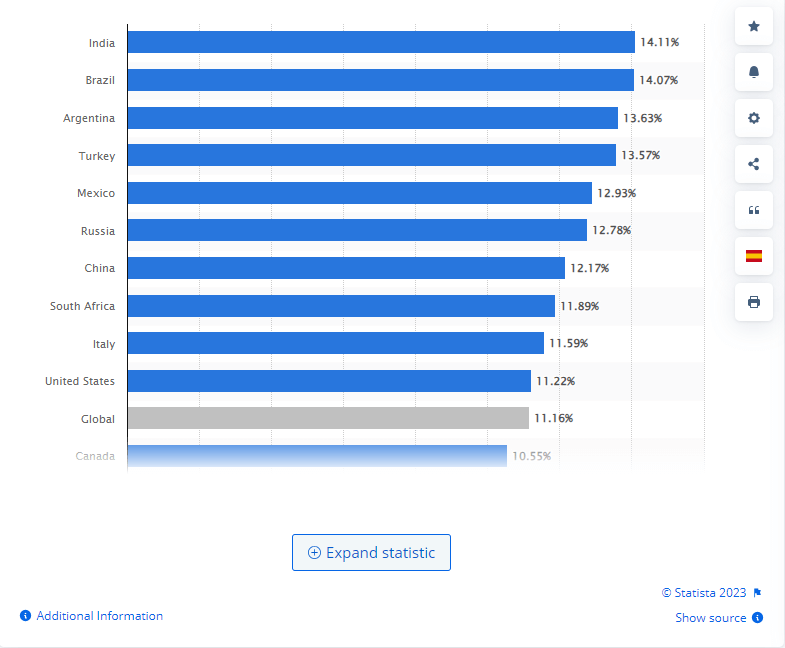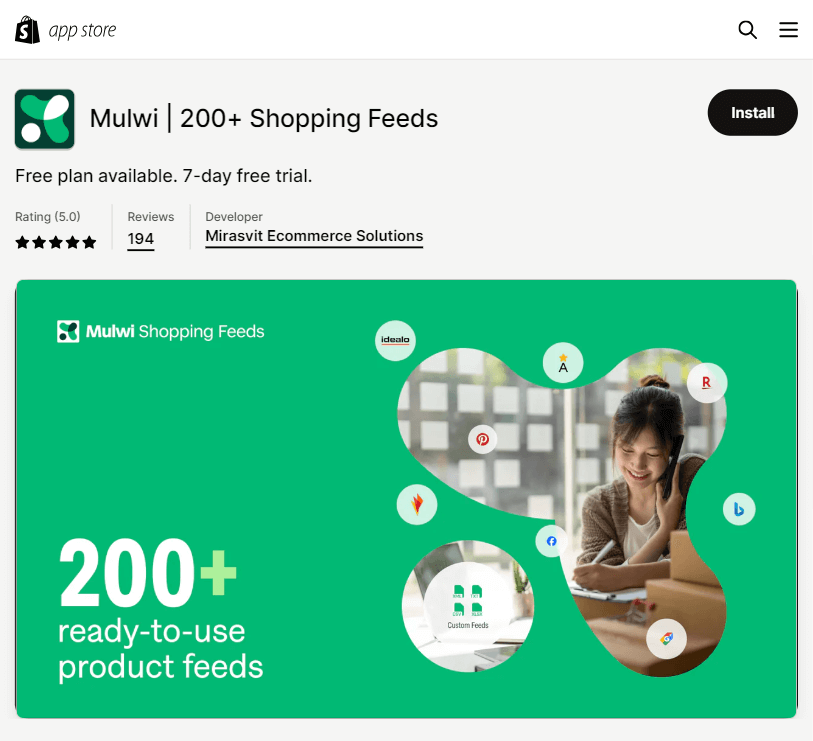In recent years, more and more people have started buying online, especially when the COVID-19 pandemic started. With five billion internet users, the number of online shoppers increases every day.
In 2023, India has become a global e-commerce leader with 14.1% annual growth. The Indian market is currently valued at $63.17 billion. Argentina and Brazil are also running ahead with a growth rate of over 13.6%. Globally, e-commerce is on the rise, with a combined annual growth of 11.16%.

Retailers willing to start selling online usually start with a website. They can hire developers and designers or agencies, which may be quite expensive. The cost depends on the degree of website elements' difficulty, deadlines, staff experience, and other factors. On average, in 2023, developers may take from $30 to $200 per hour, while agencies' costs vary from $500 to $10,000.
Another more profitable option is to use a website builder. Website builders are usually cloud platforms where you can create online stores quickly using ready templates on a monthly payment basis. Plan pricing is different, but a basic plan may cost around $20-30 per month on average. They are like busy digital shops that handle everything from showing products to processing payments and ensuring things get delivered.
Among such platforms are WooCommerce, Magento, Shift4Shop, etc. Shopify, which started in 2006 in Canada, has become really good at creating software that makes online shopping easy. It does not need a developer like Magento, for instance. Shopify now powers 4 million online stores globally, helping about 2 million retailers worldwide. It is definitely number one on the list of top website builders.
What is Shopify?
Shopify is an online platform with tools for creating and managing your online store. It includes inventory management, analytics, and multichannel marketing (sales on marketplaces, social networks, email advertising, etc.). This platform is a quick website builder for those who want to sell in foreign markets by launching a beautiful online store as fast as possible. Shopify is also good for retailers wishing to combine several sales channels in one place (online store, Google, Instagram, Pinterest, etc.).
Shopify pros and cons
So, what makes Shopify so special among others? Why did so many businesses choose this platform, among others? What are the disadvantages retailers may come across?
Advantages:
All-in-one for trading All the main online trading tools are combined in one place: online store, warehouse accounting, CRM, loyalty systems, analytics, and advertising.
Multichannel management An ability to manage sales and advertising on various channels at one site. It includes selling through marketplaces, contextual advertising, email marketing, advertising on social networks, etc.
Apps to expand functionality The Shopify App Store offers 4000+ apps to help you with store design, marketing, logistics, multichannel sales, etc. Most of them are paid and distributed on a monthly basis. But there are also free ones and applications with free plans.
Ready integrations Ready-made integrations with payment systems and delivery services (more than 100 options) for sales in any country worldwide.
Quick store launch The high speed of creating a store on Shopify is possible due to the large number of ready-made elements, their coherence, and the ability to create a simple store in design mode.
Large developer community There is a large number of freelancers and agencies working on Shopify Apps. So you will have technical support.
High-quality design templates The Shopify template store has some very good options for store templates. All you have to do is upload your content, and you will already have a high-quality store that looks great.
Disadvantages:
The site does not belong to you Shopify is a cloud-based platform. The site files are located on the platform hosting. And the store is as if it was rented. Plus, system files cannot be accessed.
You have to pay to expand the functionality Expansion of functionality is achieved mainly through paid applications. Thus, the monthly subscription fee for the store increases. But the good news is you get all the basics and essentials for free.
You can't edit checkout The "Checkout" page cannot be edited on regular plans (this option is only available in Shopify Plus, which costs from $2,000 per month). This makes it difficult to set up your own analytics, as well as a selection of delivery offices.
Limited website optimization options There is no access to hosting settings. Therefore, the ability to optimize site performance is quite limited. And the more you develop the store and install new applications, the more difficult it is to have a fast website.
Extra commissions In addition to the subscription fee, Shopify takes a commission from store sales. The commission ranges from 0.5 to 2% depending on your tariff (Basic - 2%, Shopify - 1%, Advanced - 0.5%). There is no such commission in one case - when using the Shopify Payments payment system. You also need to remember that each payment system, in addition, has its own commission for accepting payments - 2-3%.
It seems like there are a lot of downsides. But the advantages of Shopify still outweigh them. Ultimately, Shopify is chosen for its "all in one": online store + advertising + sales through different channels + the ability to quickly develop a store through applications + opportunities to scale to different markets.
How much does Shopify cost?
You can start for free and create your online store free of charge. No credit card is required. The trial period on Shopify lasts for three days. Then, you have to choose the subscription plan. Shopify also offers an option to pay $1 monthly for the first three months of using one of the plans. The payment is not necessarily monthly. You can pay yearly and save about 25% of the cost.
Shopify often offers seasonal discounts like for the Black Friday, for instance. Or the platform may make some deals like using a more expensive plan on the cheaper one’s price.
There are four main plans: Basic, Shopify, Advanced, and Shopify Plus. They all offer online store creation and management, analytics, an unlimited number of products, multichannel selling, etc. The full list of features you may find here. All the features are mostly the same except for some differences, which we will analyze nearer.
- Basic:
A perfect match for individuals, especially for beginners;
32$ per month or $24 - in case of yearly payment;
Two staff accounts for your colleges are allowed;
- Shopify:
This plan will be a good choice for small businesses aiming at business scaling;
92$ monthly or $69 - if you pay for the year;
Five staff accounts are available in case five people may need access to the store;
- Advanced:
If a medium or large business goal is to speed up sales, this plan is for them;
399$ per month or $299 - when paid yearly;
15 staff accounts;
Third-party calculated shipping rates. With third-party calculated shipping rates, you can display the shipping cost to your customers at checkout using your postal account or special apps from outside companies. It helps to ensure that your customers are charged the correct shipping amount, and you can avoid losing profits due to shipping costs.
Duties and import taxes. When you estimate and collect duties and import taxes at checkout, it helps your customers to know the total cost of their purchase up front. This approach also decreases the likelihood of a return or parcel refusal due to unexpected fees.
You can change the default reports from Shopify and create your own custom reports. This can be done using the filtering and editing features that Shopify provides.
- Shopify Plus:
This one is for large businesses aiming more at marketing and design than on sales; also for B2B sales and for the need to have different stores for different countries;
Individual prices starting from $2,000 per month;
All features are included without any limits;
Free Shopify shipping.
You can choose any plan you like according to your business needs. Although there are some differences mentioned above, the basic features needed for online trading are available in all of them. You can also upgrade your plan anytime you are ready to. It is also possible to cancel your account anytime you want.
Shopify plans for beginners
The Basic Shopify plan is the most popular and suitable for retailers willing to start selling online. It includes all they need to trade: an online store, basic reports on performance and sales, analytics, multichannel selling, etc. And the cost is lower than in other plans.
If you already have a website, you can select an alternative Starter plan and start selling on social media and messaging apps. The price is only $5 per month. It includes a simple online store (product, contacts, and checkout pages), order management, app access, a link to your website, and a mobile POS with payments via a smartphone.
There is also a plan called Retail for sellers willing to trade in person but with a simple online store. This plan is good in case you have several brick-and-mortar shops and wish to expand your reach in e-commerce. This plan costs $89 per month. Besides a simple online store, as in the Starter, it includes unlimited POS logins, two admin accounts, and retail analytics.
How does Shopify work?
Organizing an online store on Shopify is simple because it provides ready-made templates that sellers can customize to match their brand and style. Sellers can easily add products to their Shopify store by uploading pictures and other important details. Once added, these products can be organized based on inventory and product type.
Shopify also has a built-in payment system that accepts different payment methods like credit cards, e-wallets, and digital payments. This takes away the hassle of managing payments as Shopify handles them securely.
Apart from these features, Shopify offers additional tools like order management, shipping, and tax management. These tools make it easier for sellers to handle their online business and provide a smooth experience for their customers.
Inventory management
Inventory management in Shopify is the process of managing the products you have in stock and their availability. It allows you to efficiently monitor your products' quantities, variants, and locations. With Shopify's user-friendly interface, you can easily update inventory levels, receive notifications for low stock, and set up automated reorder points.
It helps you streamline your operations, reduce the risk of overselling, and ensure that customers can purchase items that are in stock. The inventory management can increase customer satisfaction and improve your overall business performance.
Analytics
The Analytics page on Shopify shows important information about your sales, orders, and visitors to your online store. It gives you a quick overview of your store's performance, including data from all your sales channels and for any selected date range.
On the Analytics page, you can do the following:
Check how much you've sold recently and compare it to a previous time period.
Compare the performance of your different sales channels.
Keep track of your average order value.
See where your visitors are coming from, whether it's a specific region or social media platform.
Monitor trends over time.
The dashboard on the Analytics page shows valuable metrics that give you insights into how your store is performing and how your customers behave. The metrics are shown as numbers and graphs when appropriate. You can also see the percentage change compared to the previous date range for all the metrics.
Multichannel selling
A multichannel selling strategy means offering your products in various places, both physically and digitally. You can sell your products in different physical retail spaces, such as traditional stores or shared spaces like farmers' markets or craft fairs. But, when we talk about online trading, you can sell your products through digital channels, including popular price comparisons like Google Shopping or marketplaces like Etsy, Rakuten, or Facebook. This approach allows you to reach more customers, increase sales, and boost conversions.
Shopify offers numerous apps helping to sell on different shopping engines. The Mulwi Shopping Feeds is one of the best of them. This app is the key link between Shopify stores and shopping engines. Based on customers' reviews, this Shopify app's independent ranking is five out of five stars. It connects sellers with 200+ marketplaces, price comparison websites, affiliates, and social media networks.
Sellers can use ready-to-use feeds or create custom feeds using templates in various formats like CSV, XML, TXT, and XLSX. The Mulwi team is also ready to create product feeds by request for any shopping channel you need free of charge.
The app offers many advanced features like Shopify markets, allowing to include international prices to the feed to sell worldwide. Sellers can change the preinstalled feed templates or create custom feeds. It means they can include or exclude the needed products, add additional fields, set up free delivery, stock location, etc. It is also possible to connect Google Translate, Weglot, or Shopify translation apps to Mulwi for feeds’ localization. The full list of features you can find here.
Mulwi works with European, American, Canadian, Australian, and more shopping engines to expand your reach. The app offers Shopify feeds for Awin, Facebook, Google Shopping, TikTok, Rakuten, Idealo, etc. The app provides direct API integrations for OTTO and CDON besides feeds.
Multichannel selling is a smart way to expand your online business and increase profits. With Mulwi Shopping feeds, you can easily connect with potential customers on various shopping engines. By adopting this approach, you can watch your business thrive in the competitive digital world.
You can install the app in the Shopify app store, but first, you need to create a Shopify store.

How to get started?
The creation of an online store is free, really fast, and easy. Just go to the Shopify website and click on the Start free trial button, which occurs many times on the landing page from the top to the bottom. You can also read more information about Shopify opportunities for sellers. So, let's get started:
Select I'm just starting and press Next to continue.
Choose An online store and click the Next button.
In the next window, you need to choose the products or services you will sell. You also can skip it by selecting I'll decide later, or you may just press Next.
Select the country where your business is located. Click Next.
Create a Shopify account. You can sign up via email, Apple, Google, or Facebook.
Make your account secure by using two-factor authentication or secondary email. You can also skip it by pressing Remind me next time.
After entering your account, you can see the admin panel of your online shop. You can choose the theme for your store, add products manually, import them via CSV file, etc. If your products have specific characteristics you want to add to your store, you can use Metafields in the Custom data tab of Shopify settings. For instance, you sell perfumes, and you need to indicate the fragrance family. You can find more detailed Shopify tutorial on how to set up your store here.
Conclusion
Shopify stands out as a friendly guide for beginners in the vast world of online selling. It's like a cool friend who knows everything about creating an online store without the confusing tech talk.
With Shopify, you're not just opening a store but joining a global community of sellers. It's the go-to platform for anyone starting their online retail journey. Plus, the process is so simple that Shopify makes it feel like a breeze, even if you've never done this before.
From ready-made templates to tools that help you with everything from payments to shipping, Shopify is like your personal online business assistant. And if you ever get stuck, a whole bunch of people are ready to help you.
The Mulwi Shopping Feeds app is one of them. It can help you with connections to various shopping engines to increase your sales and expand your reach. The app will also ease inventory management, import orders, and more in multichannel selling.





